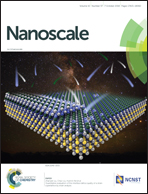Highly efficient and stable semi-transparent perovskite solar modules with a trilayer anode electrode†
Abstract
Highly efficient and stable semi-transparent CH3NH3PbI3 perovskite photovoltaic cells are realized by using an ITO/MoOx bilayer conductive oxide as the anode electrode with a cyclopenta[2,1-b;3,4-b′]dithiophene (CT) based hole-transport material (HTM), which allows bifacial illumination from both sides of the electrodes. The wide bandgap MoOx thin film is not only to be an electron blocking layer, but also to be a passivation layer which can withstand the excessive energy bombardment during the magnetron sputtering process for the deposition of a high-quality ITO thin film. Atomic-force microscopy images, transmittance spectra and water-droplet contact angle images show that the interfacial contact between MoOx and hole transport layer (HTL) strongly influences the short-circuit current density (JSC) and fill factor (FF). The highest power conversion efficiency (PCE) values for the bifacial perovskite solar cells (0.16 cm2) and modules (11.7 cm2) are 16.38% and 14.96%, respectively. In addition, the PCE of the ITO/MoOx/CT-HTM based perovskite solar module decreases slowly toward a stable value (∼11%) for more than 700 h under wet environment conditions (70 ± 5 RH%).



 Please wait while we load your content...
Please wait while we load your content...